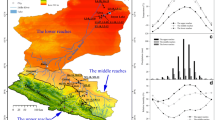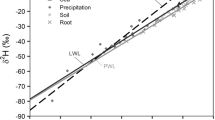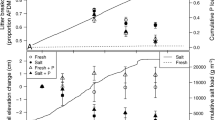Abstract
The purpose of this study was to determine the seasonal water use patterns of dominant macrophytes coexisting in the coastal Everglades ecotone. We measured the stable isotope signatures in plant xylem water of Rhizophora mangle, Cladium jamaicense, and Sesuvium portulacastrum during the dry (DS) and wet (WS) seasons in the estuarine ecotone along Taylor River in Everglades National Park, FL, USA. Shallow soilwater and deeper groundwater salinity was also measured to extrapolate the salinity encountered by plants at their rooting zone. Average soil water oxygen isotope ratios (δ 18O) was enriched (4.8 ± 0.2‰) in the DS relative to the WS (0.0 ± 0.1‰), but groundwater δ 18O remained constant between seasons (DS: 2.2 ± 0.4‰; WS: 2.1 ± 0.1‰). There was an inversion in interstitial salinity patterns across the soil profile between seasons. In the DS, shallow water was euhaline [i.e., 43 practical salinity units (PSU)] while groundwater was less saline (18 PSU). In the WS, however, shallow water was fresh (i.e., 0 PSU) but groundwater remained brackish (14 PSU). All plants utilized 100% (shallow) freshwater during the WS, but in the DS R. mangle switched to a soil–groundwater mix (δ 55% groundwater) while C. jamaicense and S. portulacastrum continued to use euhaline shallow water. In the DS, based on δ 18O data, the roots of R. mangle roots were exposed to salinities of 25.4 ± 1.4 PSU, less saline than either C. jamaicense (39.1 ± 2.2 PSU) or S. portulacastrum (38.6 ± 2.5 PSU). Although the salinity tolerance of C. jamaicense is not known, it is unlikely that long-term exposure to high salinity is conducive to the persistence of this freshwater marsh sedge. This study increases our ecological understanding of how water uptake patterns of individual plants can contribute to ecosystem levels changes, not only in the southeast saline Everglades, but also in estuaries in general in response to global sea level rise and human-induced changes in freshwater flows.





Similar content being viewed by others
References
Balasubramaniam R (2004) Investigation of salt tolerance mechanisms in the halophytes Aster tripolium L. and Sesuvium portulacastrum L. through physiological, biochemical and molecular methods. Ph.D. Dissertation, University of Hanover, Germany
Brewer JS, Grace JB (1990) Plant community structure in an oligohaline tidal marsh. Vegetatio 90:93–107
Busch DE, Smith SD (1995) Mechanisms associated with the decline of woody species in riparian ecosystems of the southwestern U.S. Ecol Monogr 65:347–370
Chen E, Gerber JF (1990) Climate. In: Myers RL, Ewel JJ (eds) Ecosystems of Florida. University of Central Florida Press, Orlando, FL, pp 11–34
Childers DL, Boyer JN, Davis SE, Madden CJ, Rudnick DT, Sklar FH (2006a) Relating precipitation and water management to nutrient concentrations in the oligotrophic “upside-down” estuaries of the Florida Everglades. Limnol Oceanogr 51:602–616
Childers DL, Iwaniec D, Rondeau D, Rubio G, Verdon E, Madden C (2006b) Responses of sawgrass and spikerush to variation in hydrologic drivers and salinity in southern Everglades marshes. Hydrobiologia 569:272–292
Chowdhury MAM, Moseki B, Bowling DJF (1995) A method for screening rice plants for salt tolerance. Plant Soil 171:317–322
Coplen TB, Wildman JD, Chen J (1991) Improvements in the gaseous hydrogen–water equilibration technique for hydrogen isotope ratio analysis. Anal Chem 63:910–912
Daoud S, Harrouni MC, Bengueddour R (2001) Biomass production and ion composition of some halophytes irrigated with different seawater solutions. In: First Int Conf on Saltwater Intrusion and Coastal Aquifers—Monitoring, Modeling and Management, 23–25 April 2001, Essaouira, Morocco, pp 23–25
Davis SM, Childers DL, Lorenz JJ, Wanles HR, Hopkins TE (2005) A conceptual model of ecological interactions in the mangrove estuaries of the Florida Everglades. Wetlands 25:832–842
Dawson TE, Mambelli S, Plamboeck A, Templer P, Tu K (2002) Stable isotopes in plant ecology. Annu Rev Ecol Syst 33:507–559
Dodd MB, Lauenroth WK, Welker JM (1998) Differential water resource use by herbaceous and woody plant life-forms in a shortgrass steppe community. Oecologia 117:504–512
Doyle TW, Girod GF, Books MA (2003) Modeling mangrove forest migration along the southwest coast of Florida under climate change. In: Ning ZH, Turner RE, Doyle T, Abdollahi KK (eds) Preparing for a changing climate: the potential consequence of climate variability and change: Gulf Coast region. Gulf Coast Climate Change Assessment Council, Baton Rouge, LA, pp 211–222
Egler FE (1952) The southeast saline Everglades vegetation, Florida, and its management. Vegetatio Acta Geobot 3:213–265
Ehleringer JR, Schulze ED, Ziegler H, Lange OL, Farquhar GD, Cowan IR (1985) Xylem-tapping mistletoes: water or nutrient parasites? Science 227:1479–1481
Ellsworth PZ, Williams DG (2007) Hydrogen isotope fractionation during water uptake by woody xerophytes. Plant Soil (in press)
Epstein S, Mayeda T (1953) Variations of O-18 content of water from natural sources. Geochim Cosmochim Acta 42:213–224
Ewe SML, Sternberg L da SL (2002) Seasonal water-use patterns of the invasive exotic, Schinus terebinthifolius, in a native and disturbed community. Oecologia 133:441–448
Ewe SML, Sternberg L da SL (2005) Growth and gas exchange responses of Brazilian pepper (Schinus terebinthifolius) and native South Florida species to salinity. Trees 19:119–128
Ewe SML, Sternberg L da SL (2007) Water use patterns of an invasive exotic plant in coastal saline habitats. J Coastal Res 23:255–264
Ewe SML, Sternberg L da SL, Busch DE (1999) Water-use patterns of woody species in pineland and hammock communities of South Florida. For Ecol Manage 118:139–148
Flanagan LB, Ehleringer JR (1991) Effects of mild water stress and diurnal changes in temperature and humidity on the stable oxygen and hydrogen isotopic composition of leaf water in Cornus stolonifera L. Plant Physiol 97:298–305
Flowers TJ, Yeo AR (1986) Ion relations of plants under drought and salinity. Aust J Plant Physiol 13:75–91
Gaiser E, Wachnicka A, Ruiz P, Tobias F, Ross M (2005) Diatom indicators of ecosystem change in subtropical coastal wetlands. In: Bortone S (ed) Estuarine indicators. CRC, Boca Raton, FL, pp 127–144
Hanson AD, Hitz WD (1982) Metabolic responses of mesophytes to plant water deficits. Annu Rev Plant Physiol 33:163–203
Ish-Shalom N, Sternberg L da SL, Ross M, O’Brien JJ, Flynn L (1992) Water utilization of tropical hardwood hammocks of the lower Florida Keys. Oecologia 92:108–112
Jackson PC, Cavelier J, Goldstein G, Meinzer FC, Holbrook NM (1995) Partitioning of water resources among plants of a lowland tropical forest. Oecologia 101:197–203
James M, Zedler J (2000) Dynamics of wetland and upland subshrubs at the salt marsh-coastal sage scrub ecotone. Am Midl Nat 143:298–311
Juszli GM (2006) Patterns in belowground primary productivity and belowground biomass in marshes of the Everglades’ oligohaline ecotone. M.Sc. Thesis, Florida International University, Miami, FL
Kozlowski TT (1997) Responses of woody plants to flooding and salinity. Tree Physiol Monogr 1:1–29 (see http://www.heronpublishing.com/tp/monograph/kozlowski.pdf)
Le Roux X, Bariac T, Mariotti A (1995) Spatial partitioning of the soil water resource between grass and shrub components in a West African humid savanna. Oecologia 104:147–155
Light SS, Dineen JW (1994) Water control in the Everglades: a historical perspective. In: Light SS, Dineen JW (eds) Everglades: the ecosystem and its restoration. St. Lucie, Boca Raton, FL, pp 47–84
Lin G (1992) Ecophysiology of growth forms in mangroves of southern Florida: stable isotope ratios, photosynthesis, and water relations. Ph.D. Dissertation, University of Miami, Coral Gables, FL
Lin G, Sternberg L da SL (1993) Hydrogen isotopic fractionation by plant roots during water uptake in coastal wetland plants. In: Ehleringer J, Hall A, Farquhar G (eds) Stable isotopes and plant carbon/water relations. Academic, San Diego, CA, pp 497–510
Loveless CM (1959) A study of the vegetation in the Florida Everglades. Ecology 40:1–9
Mensforth L, Thorburn P, Tyerman S, Walker G (1994) Sources of water used by riparian Eucalyptus camaldulensis overlying highly saline groundwater. Oecologia 100:21–28
Meyers JB, Swart PK, Meyers JL (1992) Geochemical evidence for groundwater behavior in an unconfined aquifer, south Florida. J Hydrol 148:249–272
Mitsch WJ, Gosselink JG (2000) Wetlands. Wiley, New York, p 920
Moreira MZ, Sternberg L da SL, Nepstad DC (2000) Vertical patterns of soil water uptake by plants in a primary forest and an abandoned pasture in the eastern Amazon: an isotopic approach. Plant Soil 222:95–107
Munns R (1993) Physiological processes limiting plant growth in saline soils: some dogmas and hypotheses. Plant Cell Environ 16:15–24
Munns R, Termaat A (1986) Whole-plant responses to salinity. Aust J Plant Physiol 13:143–160
Odum WE, McIvor CC (1990) Mangroves. In: Myers RL, Ewel JJ (eds) Ecosystems of Florida. University of Central Florida, Orlando, FL, pp 517–548
Prado CHB de A, Zhang W, Rojas MHC, Souza GM (2004) Seasonal leaf gas exchange and water potential in a woody cerrado species community. Braz J Plant Physiol 16:7–16
Price RM (2001) Geochemical determinations of groundwater flow in Everglades National Park. Ph.D. Dissertation, University of Miami, Coral Gables, FL
Price RM, Swart PK (2006) Geochemical indicators of groundwater recharge in the surficial aquifer system, Everglades National Park, Florida, USA. Geol Soc Am Spec Paper 404:251–266
Price RM, Top Z, Happell JD, Swart PK (2003) Use of tritium and helium to define groundwater flow conditions in Everglades National Park. Water Resour Res 39:1267–1274
Price RM, Swart PK, Fourqurean JW (2006) Coastal groundwater discharge—an additional source of phosphorus for the oligotrophic wetlands of the Everglades. Hydrobiologia 569:23–36
Ridolfi L, D’Odorico P, Laio F (2006) Effect of vegetation–water table feedbacks on the stability and resilience of plant ecosystems. Water Resour Res 42:w01201 doi:10.1029/2005WR004444
Ross MS, Meeder JF, Sah JP, Ruiz PL, Telesnicki GJ (2000) The southeast saline Everglades revisited: a half-century of coastal vegetation change. J Veg Sci 11:101–112
Ross MS, Gaiser EE, Meeder JF, Lewin MT (2001) Multi-taxon analysis of the “white zone”, a common ecotonal feature of South Florida coastal wetlands. In: Porter JW, Porter KG (eds) The Everglades, Florida Bay and coral reefs of the Florida keys: an ecosystem sourcebook. CRC, Boca Raton, FL, pp 205–238
Scholander PF (1968) How mangroves desalinate water. Physiol Plant 21:251–261
Sklar F’McVoy C, VanZee R, Gawlik DE, Tarboton K, Rudnick D, Miao SL, Armentano T (2001) The effects of altered hydrology on the ecology of the Everglades. In: Porter JW, Porter KG (eds) The Everglades, Florida Bay and coral reefs of the Florida keys: an ecosystem sourcebook. CRC, Boca Raton, FL, pp 39–82
Sternberg L da SL, Swart PK (1987) Utilization of freshwater and ocean water by coastal plants of Southern Florida. Ecology 68:1898–1905
Sternberg L da SL, Ish-Shalom-Gordon N, Ross M, O’Brien J (1991) Water relations of coastal plant communities near the ocean/freshwater boundary. Oecologia 88:305–319
Stratton LC, Goldstein G, Meinzer F (2000) Temporal and spatial partitioning of water resources among eight woody species in a Hawaiian forest. Oecologia 124:309–317
Sutula M, Day JW, Cable J, Rudnick D (2001) Hydrological and nutrient budgets of freshwater and estuarine wetlands of Taylor Slough in Southern Everglades, Florida (U.S.A.). Biogeochemistry 56:287–310
Swart PK, Price RM (2002) Origins of salinity variations in Florida Bay. Limnol Oceanogr 47:1234–1241
Tomlinson PB (1980) The biology of trees native to tropical Florida. Harvard University, Allston, MA, p 480
White WC, Cook ER, Lawrence JR, Broeker WS (1985) The D/H ratios of sap in trees: implications for water sources and tree ring D/H ratios. Geochim Cosmochim Acta 49:237–246
Wilcox WM, Solo-Gabriele HM, Sternberg L da SL (2004) Use of stable isotopes to quantify flows between the Everglades and urban areas in Miami-Dade County Florida. J Hydrol 293:1–9
Acknowledgments
We thank G. Losada, T. Grahl, and G. Koch for field assistance, Greg Juszli, and the Wetland Ecosystems Ecology Laboratory for helpful comments on an earlier draft. We also thank the two anonymous reviewers for their helpful comments and Dr. Carlos Coronado (South Florida Water Management District) for kindly allowing the use of his aerial picture of the field site. This material is based on work supported by the National Science Foundation through FIU’s Florida Coastal Everglades LTER program (Grant #9910514) and the University of Miami’s Biocomplexity Grant #0322051. This manuscript is a Southeast Environmental Research Center Contribution No. 344.
Author information
Authors and Affiliations
Corresponding author
Additional information
Communicated by Evan DeLucia.
Rights and permissions
About this article
Cite this article
Ewe, S.M.L., Sternberg, L.d.S.L. & Childers, D.L. Seasonal plant water uptake patterns in the saline southeast Everglades ecotone. Oecologia 152, 607–616 (2007). https://doi.org/10.1007/s00442-007-0699-x
Received:
Accepted:
Published:
Issue Date:
DOI: https://doi.org/10.1007/s00442-007-0699-x




